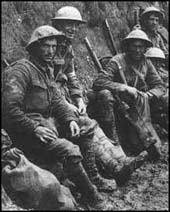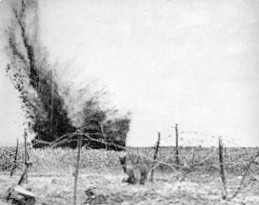2nd Battalion, East Surrey Regiment:
2nd Battle(s) of Ypres (1915):
The Second Battle of Ypres as it is known in British military history consisted of four battles, which took place between the 22 April to 25 May 1915 in the northern sector of the Ypres Salient. The offensive began with an attack on the allied front line by the German 4th Army on Thursday 22 April at 17.00 hours (British time). This attack, known as The Battle of Gravenstafel Ridge, witnessed the first use of poisonous gas by the German Army on its western front.
The 2nd Battalion of the East Surreys was part of the 85th Brigade, 28th Division. Other units in the 85th Brigade included:
-
2nd Bn The Buffs
-
3rd Bn The Royal Fusiliers
-
3rd Bn The Middlesex Regiment
-
1/8th Bn The Middlesex Regiment
-
85th Brigade Machine Gun Company
-
85th Brigade Trench Mortar Battery
-
85th Brigade Small Arms Ammunition Supply Section.
The Battle of St Julien - 24th April - 4th May 1915
The Battle of Frezenburg - 8th - 13th May 1915
The Battle of Bellewaarde - 24th - 25th May 1915
25th May - 25th September 1915 : Remained in France
The Battle of Loos - 25th September - 8th October 1915
I Corps: 2nd, 7th, 9th & 28th Divisions
In May 1915, Henri-Philippe Petain and 9th French Army launched an attack at Artois. Petain initially made good progress but was unable to take the main objective, Vimy Ridge. On 25th September Anglo-French forces launched another offensive at Artois and at nearby Loos. The 2nd Battalion fought at the Hohenzollern Redoubt and the Cuinchy Brickstacks.

General Sir Douglas Haig, and the British First Army, attacked at Loos. By the end of the first day the British troops were on the outskirts of Lens. Strong counter-attacks by the Germans forced the British back. When a second British attack suffered heavy losses on 13th October, Sir John French, decided to being an end to the Artois-Loos offensive. The campaign cost the British Expeditionary Force 50,000 casualties. The French lost 48,000 and the Germans about 24,000.
In October 1915 the battalion embarked at Marseilles, and proceeded to Egypt arriving at Alexandria on 30th October.
On the 26th November, the 2nd Battalion embarked for Salonika, arriving on 1st December 1915.
They were sent to reinforce the combined Franco-British force that had landed in Macedonia at the request of the Greek Prime Minister. Their aim was to help the Serbs in their fight against Bulgarian aggression and later against the Turks.
Dec 1915 - Feb 1917 : Operations in Struma Valley, Macedonia
Feb 1917 - Nov 1918 : Operations around Lake Doiran, Macedonia
Bulgaria attacked Serbia in October 1915. This new threat led Serbia to appeal to the British and French governments for military assistance. At the same time Greece asked the Allies for help with their treaty obligations to Serbia. The British and French sent a small force which began landing at the Greek port of Salonika (Thessalonika) at the end of October. They advanced into Macedonia but were too late to help the Serbs who had to retreat through the Albania mountains. The Allies then withdrew back to Salonika and set up an entrenchment camp around the town known as the "Bird cage" and waited for the Bulgarians to attack. The Bulgarians did not advance on Salonika, but instead consolidated their gains in Macedonia.
The British continued to build up their forces, and by early 1916 the force had increased from just the 10th (Irish) Division to the 10th, 22nd, 26th, 27th and 28th divisions. The Allies advanced up to the Serbian frontier and liberated Monastir. Trench warfare then began. The Allies attacked in the spring of 1917, but failed to break through. However, in September 1918 they attacked again and within two weeks had obtained Bulgaria's unconditionally surrendered.
The campaign in Macedonia was considered by many to be a "side-show". The Allied army was known back home as the "Gardeners of Salonika" due to the apparent lack of activity and people would comment "If you want a holiday, go to Salonika". Despite the view of those at home, life in Macedonia was far from easy. The British Salonika Force not only had to cope with the extremes in temperature but also malaria. In 1916 it was possible to evacuate the most serious cases. However, with the introduction of unrestricted submarine warfare in April 1917 this was no longer possible. Consequently the cases of malaria soared as the infected men were compelled to stay in Macedonia. Hospital admissions in 1917 alone were 63,396 out of a strength of about 100,000 men. By early 1918 the British were again able to evacuate the worst cases and under the 'Y' scheme nearly 30,000 were evacuated.
Many men suffered numerous relapses made worse by having to remain in Macedonia. Even when they were finally evacuated many would still suffer relapses for many years to come.
The 2nd battalion remained in Macedonia for the duration, ending the war at Dzuma Obasi, north of Lake Doiran. The regiment was awarded the battle honours "Struma", "Doiran 1918" and "Macedonia 1915-1918" as a result of their endeavours.
Brief History of the 2nd Battalion::
The 2nd Battalion East Surrey Regiment has a long history that dates back to 1702, when it was raised as a regiment of marines. In 1714 it was converted from a marine regiment to a regiment of Foot and became the 31st Regiment of Foot.In 1756 a second battalion was formed and in 1758 this became the 70th Regiment of Foot.
In 1782, the 70th was known as the 70th (Surrey) Regiment of Foot.
By 1812 it was known at the 79th (Glasgow Lowland) Regiment of Foot but reverted back to being called the 70th (Surrey) Regiment of Foot in 1825.
In 1881 the 70th amalgamated with the 31st Regiment of Foot to form the East Surrey Regiment. The 70th became the 2nd Battalion East Surrey Regiment. The 31st Regiment of Foot became the 1st Battalion East Surrey Regiment.
On the 14th October 1959, the East Surrey Regiment and the Queen's Royal Regiment amalgamated to form the Queen's Royal Surrey Regiment.

Battle Honours::
RELIEF OF LADYSMITH 1900BATTLE OF TUGELA HEIGHTS
STRUMA
DOIRAN 1918
MACEDONIA 1915-1918